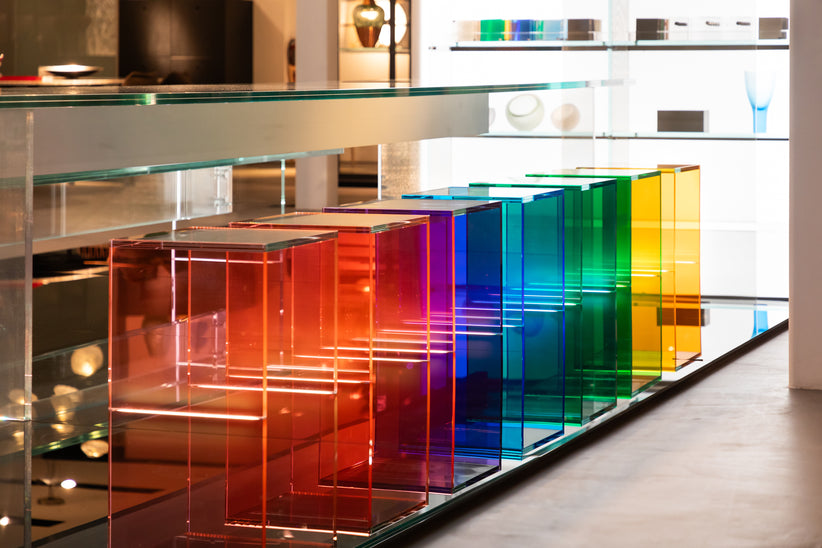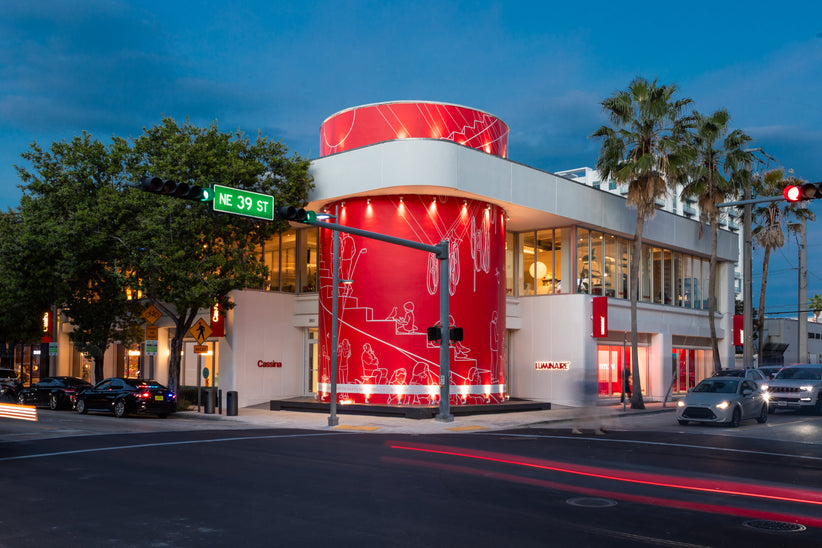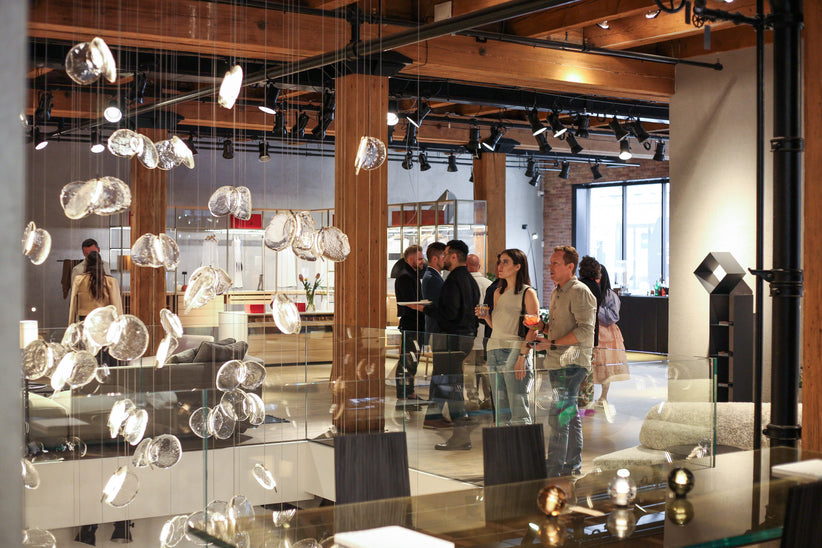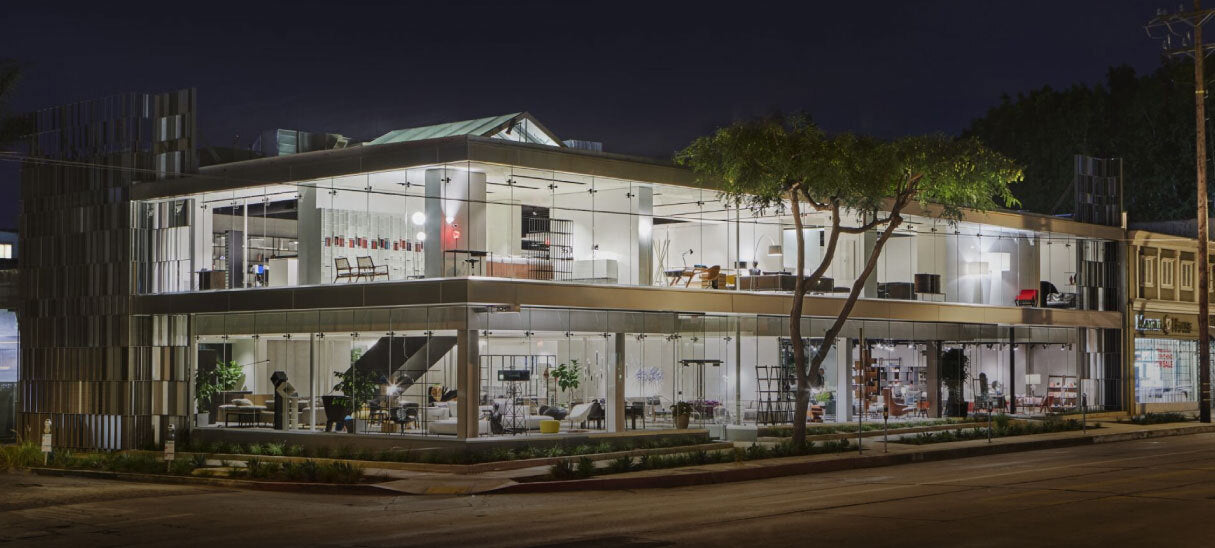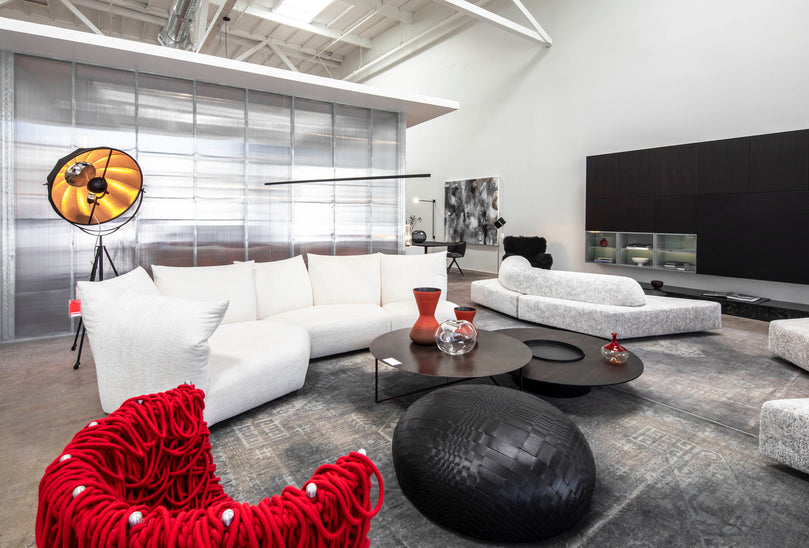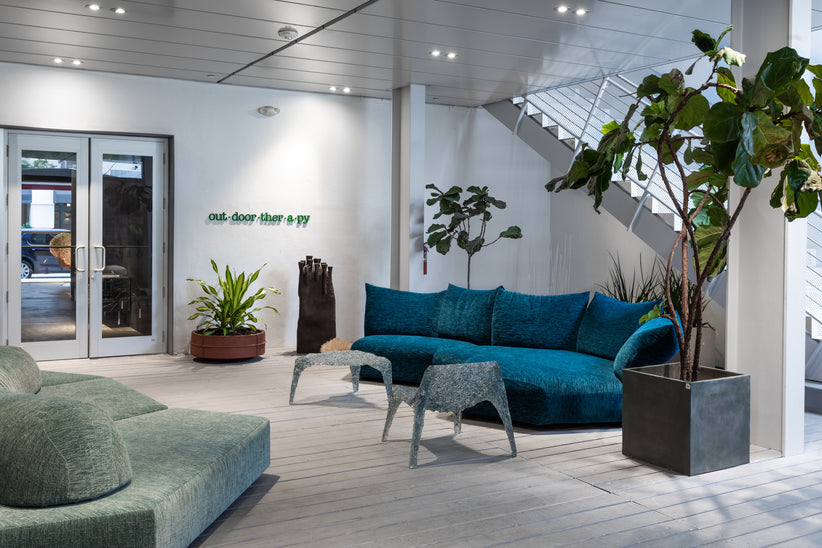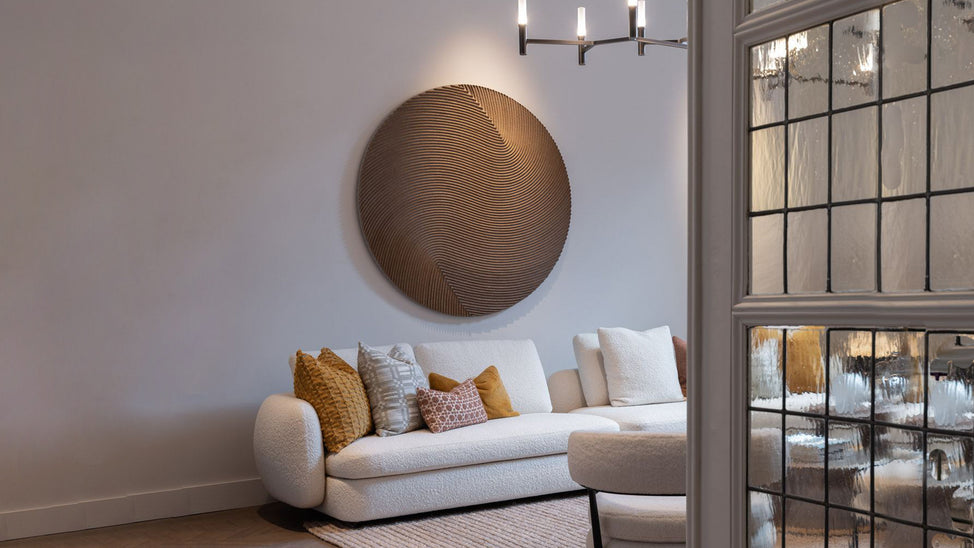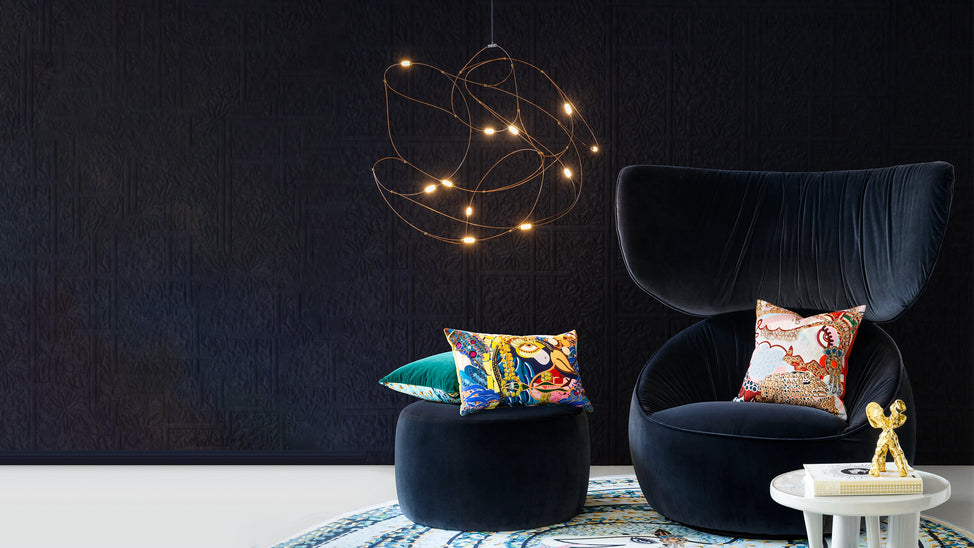In early April of every year, the population of Milan swells with hundreds of thousands of designers, architects, journalists, and design aficionados who descend on the northern Italian city in search of the latest concepts in furniture and design. Now in its 58th year, the Salone del Mobile Milano brings intense energy that transforms the fairgrounds as well as the city center and its medieval streets into a bellwether for the state of design.
Design week as a whole brings Italian furniture brands, international design manufacturers, independent designers, and, more recently, recognizable brands from the world of fashion, technology, and lifestyle together to showcase their point of view on the world of design and architecture. Luminaire has visited the fair for over 40 years, using it as a trip of discovery. Through the numerous installations, countless fair stands, and ad hoc experiences around the city, Luminaire explored the next wave of products, voices, and theories which set the pace for the future direction of design with some pleasant surprises and memorable product launches.
As a whole, the fair felt fresh this year, with many brands balancing adherence to their DNA while pushing boundaries for innovative and appealing products. At Porro, there was a palpable sense of innovation with the Italian brand building upon its expertise in case goods to create a proposal where their storage systems become architecture themselves rather than an application onto architecture. Their Modern storage collection grew, becoming expansive walls and dividers between spaces within their stand. The detailing was also reimagined, with newly patented hinges and accessories providing a bespoke level of good design. Their closet system, Storage, also found updates aesthetically and functionally. New finishes, seamlessly integrated lighting, and more sizes and composition possibilities placed their closet system at the front of any competition.
Another brand which stayed true to its identity while making a statement was Flexform. Known for their focus on ultra-comfortable seating and fine craftsmanship, they brought their design language to a new area- the terrace. Flexform’s new outdoor collection made an impressive debut for the sheer fact that it was more than a few pieces. Instead, they simultaneously launched several families of furniture for the outdoors at once including outdoor versions of existing products and completely new designs. Their fabrics, finishes, and comfort levels were also undeniably Flexform.
Outside of the fair, Paola Lenti’s exhibition near the Prada Foundation furthered the unique vision of the brand. In Lenti's signature vivid hues, a range of furniture for indoors and out was integrated with iconic vintage furniture upholstered in the brand's signature fabrics. This balance between old and new created a pleasant tension which resulted in captivating vignettes that exuded a sense of modern living.
Cassina as well found a way to look to the future of design while paying homage to its history. The storied Italian manufacturer featured reintroductions of iconic pieces by the likes of Pierre Jennerett, Gerrit Rietveld, and Le Corbusier which were styled in living arrangements with new products from Patricia Urquiola, the Bouroullec brothers, and more. Exhibiting within their showroom on Via Durini, their display this year felt fresh yet comfortable, providing warmth and serenity that was accentuated by the inclusion of a curated selection of modern artwork.
A new addition to the fair this year, a full hall was devoted to S-Project, a special assortment of brands hand selected by Salone organizers. Here, B&B Italia, who had not shown at the fairgrounds in 17 years, exhibited in a massive stand alongside other brands within their holding group. Celebrating the 40th anniversary of Antonio Citterio’s Deisis Sofa and the 50th anniversary of Gaetano Pesce’s Up Series, B&B Italia created an exhibition of these pieces plus new additions for the year. This exposition took on the appearance of a museum-like exhibition with furniture shown alongside the components that create the finished piece on long white platforms with dramatic lighting. In addition to the exhibition, B&B Italia featured a more traditionally vignette-based exhibit of their latest furniture collection including Piero Lissoni’s new sofa, Dock. The new sofa system’s shape is based around a solid platform which supports eclectic compositions that span horizontally. The platform is a dynamic element, which extends for the sofa’s entire length to form a base. The cushions play with sizes and proportions, making it possible to create double-sided, corner and chaise lounges compositions. Dock can also be developed vertically and is equipped with accessories that allow the creation of a varied landscape.
Part of the B&B Italia stand, Flos, created an experience nearly unrivaled in scale alone. Within its extra large stand, Flos continued to innovate by showcasing new lighting technologies for the residential and commercial markets with products created by an impressive roster of design talent. New systems by Michael Anastassiades, Piero Lissoni, and the Bouroullec brothers reimagined the way in which lighting systems can accentuate architecture and create a sense of place. For interior lighting, Flos also went back to its roots, showing production versions of historic lighting designed by longtime collaborators Achille and Piero Castiglioni and a new version of Mario Bellini’s Chiara light.
Beyond their expansive range of indoor lighting, Flos also proposed several new exterior lighting families. In a terrace-like setting complete with a multitude of trees and landscaping, lighting by designers including Nendo and Patricia Urquiola were displayed in a darkened area, giving a real feeling of spending an evening outdoors. For Nendo’s collection, the Japanese studio played with elementary forms where a sphere of light seemed to impossibly be held within a metal frame in a variety of forms.
In addition to the Salone Internazionale del Mobile, the biannual Euroluce took place this year where numerous brands showed innovation and creativity not only in technology and materials but in design as well. Bocci, Michael Anastassiades, and Davide Groppi created the most memorable experiences with unique stands and captivating products.
Canadian brand and long-time partner of Luminaire, Bocci, created a strong display within their impressively-designed stand. The stand’s walls were lifted off of the floor which was left bare, calling attention to the ceilings above and in turn, new introductions by Omer Arbel. Among revisits to existing pieces in the collection were a number of new products including their new answer to track lighting- a web of wires passing back and forth between walls which held magnetic spherical light elements which could be positioned in any direction. Bocci also introduced new versions of plug-in lighting, taking their most iconic pieces away from the ceiling and allowing them to be placed anywhere within the home.
At Michael Anastassiades’ serene stand, the designer seemingly took inspiration from the architectural elements of places of worship to create a sublime display of his latest mobiles and other lighting designs. Outfitted in corten steel like-material, the fair stand featured one side of modules that displayed the lighting opposite a long bench where one could reflect upon the poetic designs.
Davide Groppi, celebrating its 30th anniversary, showcased new lighting that featured minimal details and forms reduced to their most essential elements. Building upon his recent designs Infinito and Flash, Groppi launched OHM, a new, slender cylindrical downlight that rested on a taut wire.
Beyond exhibits of individual showrooms and brands, the city features a seemingly endless array of exhibitions and concept shops. At Rosana Orlandi, the iconic Milanese design gallery is known for showcasing emerging designers during the fair, a long-time friend of Luminaire Nao Tamura introduced a new collection of portable lighting. Rooted in the concept of refraining from creating disposable design, the designer’s latest collection uses quality materials and clever forms for a range of lights that are designed to be used and treasured.
Installations and exhibits abound as well, and this year, Nendo partnered with climate control company Daikon to produce a captivating exhibition of 17,000 abstract flowers arranged carefully in a setting that resembled a rolling meadow. Creating a sense of movement without a breeze or noticeable movement of lighting, the installation used polarizing lenses for the flowers and on the lighting above. The polarizing lenses on the downlights would move, without changing any lighting in the space, and interact with the flowers below to shift the shadow, giving the impression of a field of flowers moving in the breeze.
A continued theme of Design Week in recent years, sustainability and efficiency underpinned many exhibitions. One of the most remarkable examples of this was Broken Nature, the Paola Antonelli curated exhibit that opened at the Triennale during the fair. The wide-ranging exhibition seeks to find how design can mend the fraying connections between humans and nature. Here, designers illuminated the state of our changing world and the stress on precious resources through provoking works.
Altogether, 2019 Design Week in Milan saw a multitude of innovation in products, ecology, and theory. With clever styling, solid product introductions, and large scale ideas, the fair left us feeling optimistic about the direction of design.
April 2019


